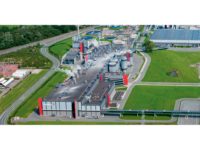Innovation fuels our industry, empowering architects and contractors to do more and do it better every year. And the innovation happens quickly. We can see the evolution of design and building envelope options from year-to-year at the industry’s leading shows. Advances in building science and technology are bringing new materials to market that are lighter and more energy-efficient, promote safety and enable some truly spectacular designs. But even among all our new options, sometimes a material we thought we knew can surprise us, especially when viewed in the context of today’s building enclosures. That’s becoming the case with cellular glass insulation, which is getting renewed attention from many architects and designers, particularly for mission critical buildings.
What is Cellular Glass?
Just like any glass, the primary ingredient in cellular glass insulation is sand. The sand is mixed with other ingredients including limestone, soda ash and recycled glass to form a molten compound. Through a process of more mixing, crushing and heating again, the compound goes through a chemical reaction that results in a glass matrix of millions of hermetically sealed glass cell bubbles. This matrix provides an array of performance benefits that are different from other roofing insulation material options and offer several advantages in mission critical buildings.
Cellular glass was developed in Europe more than 70 years ago and became a popular option for commercial building roofs in the U.S. from the 1960s-1980s. Many of these roofs continue to be in service across the nation today. In the late 1980s, the introduction of new roofing material options captured the market’s attention and use of cellular glass declined in the U.S. as interest in the new offerings grew. However, cellular glass continued to be used extensively across Europe, where it was prized for its performance characteristics.
Now, as more architects are being tasked with designing buildings that serve mission critical purposes, cellular glass is getting a second look—especially when it comes to the roof. A building’s “critical mission” might be protecting invaluable treasures or housing classified documents and processes. Any leak or rupture in the roofing membrane of a mission critical building could result in losses very difficult to replace or even irrecoverable. To help protect mission critical roofs, Owens Corning recently launched FOAMGLAS® cellular glass in the U.S. In roofing applications where performance and redundancy are top concerns, cellular glass is an excellent option.
A Cellular Glass Case Study: The Jardine Water Treatment Plant
The James W. Jardine Water Filtration Plant sits adjacent to Chicago’s Navy Pier, on the city’s iconic lakefront. Processing a billion gallons of water per day, the Jardine plant has reliably supplied the water needs of Chicago and its suburbs for more than 50 years. When the building was originally constructed, Owens Corning® FOAMGLAS® cellular glass rigid foam was used as the roofing insulation. The roof performed admirably for decades, exposed to the harsh Chicago climate on the outside and a constant mix of water vapor and chemistry inside. But, eventually, the roofing membrane had to be replaced. The design team noted that the cellular glass insulation layer had not deformed, deflected or been damaged over its many decades of use. So, they decided when it was time to replace the roof, cellular glass would again be used as the insulating layer.
The Jardine plant is a prime example of a mission critical building. It supplies water to 5.5 million Chicagoans and any interruption or incursion of contaminants would have the potential to disrupt daily life, commerce—even pose a threat to public health. Every roof membrane will be exposed to stress over time, opening up the risk of leaks and deterioration. For the Jardine plant, a redundant layer of protection was vital. Cellular glass provided that assurance.
Mission Critical Redundancy
Whether a building is protecting a city’s water supply, a bank of critical data servers or a gallery of priceless artifacts, every mission critical building is characterized by the extreme disruption or loss that could occur from even minor damage. Roofs are areas of extreme vulnerability in these structures.
When a roofing membrane is compromised (and it’s a question of “when”, not “if”), cellular glass insulation serves as a secondary, watertight layer. Like any glass container, cellular glass is impervious to moisture—both liquid and vapor. Cellular glass can be adhered and sealed with asphalt or cold adhesive without breaking down. This allows for more effective sealing at joints and seams.
Additional Performance Benefits of Cellular Glass
Compressive strength
In many mission critical buildings, the roof may serve multiple purposes, housing a parking deck, green space, HVAC equipment, solar panels and more. Cellular glass offers superior compressive strength when a roof needs to do more than cover a building. Indeed, the highest compressive strength ratings for foam plastics are just the starting point for cellular glass. Even under heavy loads, cellular glass won’t deflect or move.
Resistance to acids and chemicals
Cellular glass is inert, so it’s not affected by chemical compounds that may deposit on the roof. In some cases, a roofing material must also handle assaults from the inside—for example, the corrosive chemicals used in natatoriums. A humid, chemical-rich environment can eventually eat away at plastic and rubber roofing materials but won’t damage cellular glass. And as a non-organic material, cellular glass doesn’t promote mold or bacteria growth.
Adaptability
When viewing the roof as part of the totality of a building’s enclosure, it’s important to note that cellular glass can be used below the roof as well. The high R-values of cellular glass help prevent thermal bridging. Cellular glass is a structural insulation, so it can be used below-grade, and the ci path can cross over a load resolution path.
Sustainability
Cellular glass doesn’t contain any flame retardants or binders and it contributes to overall green building goals. It’s also easy for contractors to cut and install using techniques they already know, so there’s no special training required.
As our industry looks to constantly improve our options for building enclosure solutions, it’s important to have access to a broad range of tools and materials. For mission critical buildings, cellular glass deserves renewed attention as a viable and valuable option for roofing insulation systems where redundancy and resilience are top concerns.



